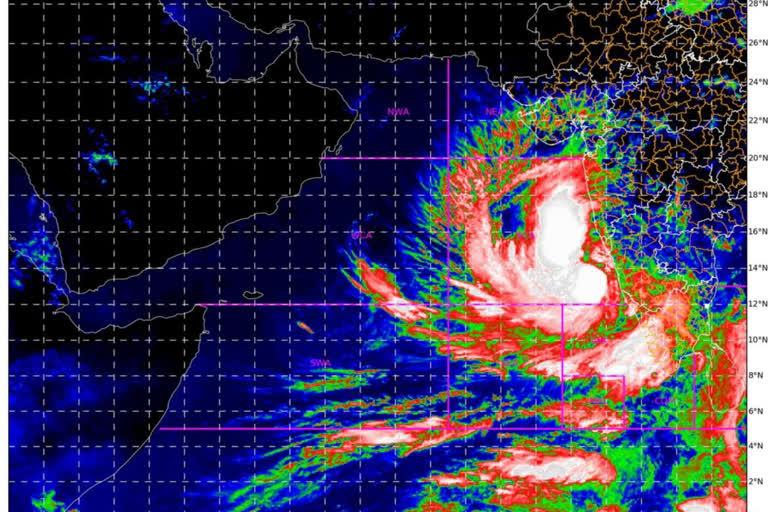Hyderabad: The peculiarity of the name Tauktae is garnering huge attention. The name Tauktae has been suggested by Myanmar which means a vocal lizard in the Burmese language.
When are cyclones named?
When the speed of a storm wind reaches or crosses 74 mph then it is considered to be a Cyclone, hurricane, or typhoon. Only when a storm becomes a Cyclone it is given a name.
How are they named?
The India Meteorological Department (IMD) recently released a list of 169 names of future tropical cyclones that would emerge in the Bay of Bengal and the Arabian Sea.
Cyclones that form in every ocean basin across the world are named by the regional specialised meteorological centres (RSMCs) and Tropical Cyclone Warning Centres (TCWCs). There are six RSMCs in the world, including the India Meteorological Department (IMD), and five TCWCs.
Also read: Cyclone Tauktae gets its name from a gecko
As an RSMC, the IMD names the cyclones developing over the north Indian Ocean, including the Bay of Bengal and Arabian Sea, after following a standard procedure. The IMD is also mandated to issue advisories to 12 other countries in the region on the development of cyclones and storms.
History of naming cyclones
The history of naming hurricanes dates back to the early 19th century with people naming storms after the places they hit, names of the saints on whose day the hurricane occurred, or simply the year of their occurrence.
The practice of naming tropical cyclones is said to be initiated by well-known meteorologist Clement Wragge during the late 19th century.
In the beginning, storms were named arbitrarily. For instance, a storm over the Atlantic in 1842 was known as Antje's hurricane because it ripped off the mast of a boat named Antje.
During the mid 20th century, western meteorologists started naming cyclones using some common women names for ease of identifying when there are multiple systems over a particular ocean basin.
Fortunately, this seemingly gender-biased system came to an end by 2000 after several protests. In 1997, Hong Kong proposed using local names for regional cyclones rather than using the European and American names.
In 2000, the World Meteorological Organisation (WMO) agreed to start assigning names for cyclones over the North Indian Ocean using a list of names suggested by the countries surrounding the ocean basin.
Initially, India expressed reservations to naming cyclones and after four years of continuous deliberations, the India Meteorological Department (IMD) named the first tropical cyclone as Onil in September 2004.
Process of naming
There are six regional specialised meteorological centres (RSMCs) and five regional Tropical Cyclone Warning Centres (TCWCs) across the globe to monitor cyclogenesis, issue advisories and name cyclones.
IMD's RSMC in New Delhi is one among them that provide advisories to 13 countries in the north Indian Ocean basin: Bangladesh, India, Iran, Maldives, Myanmar, Oman, Pakistan, Qatar, Saudi Arabia, Sri Lanka, Thailand, United Arab Emirates and Yemen.
RSMC, New Delhi is also responsible for naming cyclones over the Bay of Bengal and the Arabian Sea.
As per the WMO guidelines, a list of 64 names was drawn in 2004 using the suggested names from eight countries in the region.
Also read: Cyclone kills two in Goa, CM confirms
Cyclone Amphan was the last cyclone to get its name from the old list. Out of several criteria for naming cyclones, some very important ones are: names should be politically and culturally neutral, should not be rude and cruel and should be short, easy to pronounce.
The maximum permissible length of the cyclone names is eight letters.
In 2020, a new list of cyclone names was issued by IMD, following WMO guidelines.
The new list comprises 13 names of cyclones each for the 13 member countries, totalling to 169.
The names for India include Gati, Tej, Murasu, Aag, Vyom, Jhar, Probaho, Neer, Prabhanjan, Ghurni, Ambud, Jaladhi and Vega.
After Amphan, the naming will start from the first list starting with Nisarga, Gati and so on. After 13 cyclones, when the List 1 is fully used, the naming would resume from List 2 and so on.
Why is it important to name cyclones?
Adopting names for cyclones makes it easier for people to remember, as opposed to numbers and technical terms. Apart from the general public, it also helps the scientific community, the media, disaster managers etc.
With a name, it is easy to identify individual cyclones, create awareness of its development, rapidly disseminate warnings to increased community preparedness and remove confusion where there are multiple cyclonic systems over a region.
What cyclone names has India suggested?
The 13 names in the recent list that have been suggested by India include: Gati, Tej, Murasu, Aag, Vyom, Jhar (pronounced Jhor), Probaho, Neer, Prabhanjan, Ghurni, Ambud, Jaladhi and Vega.
Some of the names picked by India were suggested by the general public. An IMD committee is formed to finalise the names before sending it to the PTC.
Here is the complete list of 169 names. The first cyclone name which will be chosen will be the one in the first row of the first column — Nisarga by Bangladesh.
Next, India’s choice, Gati, will be chosen, and so on. Subsequent cyclones are being named sequentially, column-wise, with each cyclone given the name immediately below that of the previous cyclone. Once the bottom of the column is reached, the sequence moves to the top of the next column.



